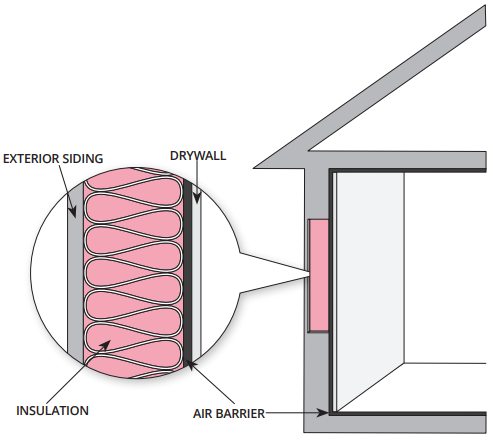Need help navigating retrofits?
Register for free today!
Air Barrier & Insulation
Three essential elements of an energy-efficient home are airtightness, high levels of insulation, and whole-house ventilation. Combine all three, you get a comfortable, low-energy, lower carbon home with excellent indoor air quality year-round and lower heating and cooling bills. Additional benefits include reduced drafts, noise, and moisture problems.
What are the Benefits?
Consistent comfort: Reduces drafts and maintains more even temperatures throughout your home.
- Quiet comfort: Reduces unwanted outdoor noise.
- Save money: Reduced energy consumption results in lower utility bills.
- Climate friendly: Reduced heat loss means less energy is needed to heat your home, resulting in a smaller carbon footprint.
- Reduced maintenance costs and improved durability: A better building envelope protects against the negative impacts of moisture such as mold and rot. This creates a longer lasting, healthier home.
How does it Work?
The air barrier can be on the inside or outside of the wall and reduces air leakage. Ample insulation slows down the transfer of heat and cold between the inside and outside, keeping your home warm in the winter months and cool in the summer.

What are the Costs?
It is more cost-effective to have a well-insulated, airtight house with mechanical ventilation than a poorly insulated house that relies on leaks and holes in the walls for fresh air. The cost of a tight air barrier and ample insulation is offset by reduced heating and cooling costs over the life of the home.
The Best Building Envelope for Your Home
Proper installation and attention to detail is critical to ensure your home has an optimal building envelope.
Consult with experts
Ask your builder, renovator, or energy advisor how a tight air barrier and ample insulation could transform your home.
Buy quality
Ask your builder or renovator about different types of insulation and air barrier systems to ensure long life and optimal performance.
Use an accredited installer
Consider using a CleanBC Better Homes Program Registered Contractor (www.betterhomesbc.ca/find-a-contractor) or an accredited BCICA (BC Insulation Contractors Association) installer to ensure proper installation.
Ensure optimal performance
Talk to your builder or renovator about careful placement of insulation to eliminate gaps, voids, and compression, a tight air barrier to control the movement of air and moisture, and appropriate ventilation with heat recovery.
Maintain your home’s envelope
Inspect your home’s exterior regularly for any damage from weather or pests and repair promptly to ensure your building envelope is intact and performing properly.
Your Home Energy Label
A tight air barrier and ample insulation are two of the many components that work together to make an energy efficient home. Ask your new construction builder or renovator to have a registered energy advisor provide an EnerGuide rating and label to recognize your investment and verify the energy efficiency of your home.
Additional Resources
Combine provincial and federal programs for maximum rebates!

